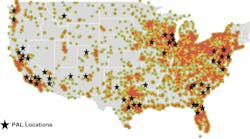Around the campfires of dying dot-coms, melancholy former executives stare into the last glowing embers and sing: “Oh give me a home where technology roams, where the venture investors will stay. Where seldom is heard a new bankruptcy word — and gross income exceeds our gross pay.”
Yes sir, it can be downright gloomy now that the Technology Gold Rush has ended. So gloomy, that it's easy to overlook the fact that there are other high-tech, start-up companies still in operation and making a real success of it. One such company is The IntraUSA Group, Tukwila, WA. Like many other startups, Intra is funded entirely by venture capital, but unlike so many others, this market newcomer is growing — not closing its doors. “In September of 1999, we were a Power Point presentation and a topped-out VISA card,” recalls Aly Jetha, president and CEO. “This year, we expect to see about $500,000 to $1-million in revenue.”
Intra develops and markets DC power management products based on its proprietary semiconductor technologies. The Intra Switch, the core of the company's technology, operates in the class of MOSFET switches. However, while standard solid-state switches work in the 50-amp range, the Intra Switch can handle extremely high amounts of current, up to about 3,000 amps, with very low heat generation, according to Will Watson, vp-sales.
“There's not another switch on the planet that does what ours does,” he says. “It makes the use of DC power more efficient, clean and reliable. We can bring semi-conductor technology, and therefore intelligent DC power management, to industries and applications that have not been able to use it before.”
Trucking is one such DC-dependent industry, and one of the first problems Intra has tackled is battery drain in dormant vehicles. “When trucks sit parked for a week or two at a dealership or in a yard, the drain on the batteries often discharges them to the point that they can no longer start the trucks,” explains Watson. “The cost and labor involved with jumpstarts alone is significant, but because batteries often ‘die’ after a deep discharge, battery replacements also contribute to the cost. Ryder Systems recently asked us to find a solution to this.”
The solution is Intra's new Jumpstart Prevention Kit. It is a unique application of the company's technologies. When the portable tool is connected to a truck, it continually monitors current draw from the battery. If the battery voltage drops to a critical level, the battery is automatically disconnected, preserving enough power to start the truck and save the battery.
Intra's Headlamp Life Extender also uses the company's proprietary technology. This time to significantly lengthen headlamp life by providing a soft-start to the filaments, regulating DC voltage and eliminating voltage spikes. It is available exclusively through Truck-Lite, one of Intra's growing list of partners.
Good partnerships are, in fact, one of the factors behind Intra's success. “We have a very real business plan and a very tangible and unique product,” Jetha notes from his modest office. “Now we are growing our business by staying focused on what we do best — developing new applications for our core technologies and then forming partnerships with other companies to produce and sell those products,” he says.
The demise of so many technology start-ups in recent months taught the business world much about the causes of failure. It is a happy irony, therefore, that there are also lessons to be learned or relearned about success from high-tech start-ups like Intra — lessons that will be valuable in the rebuilding months ahead.


